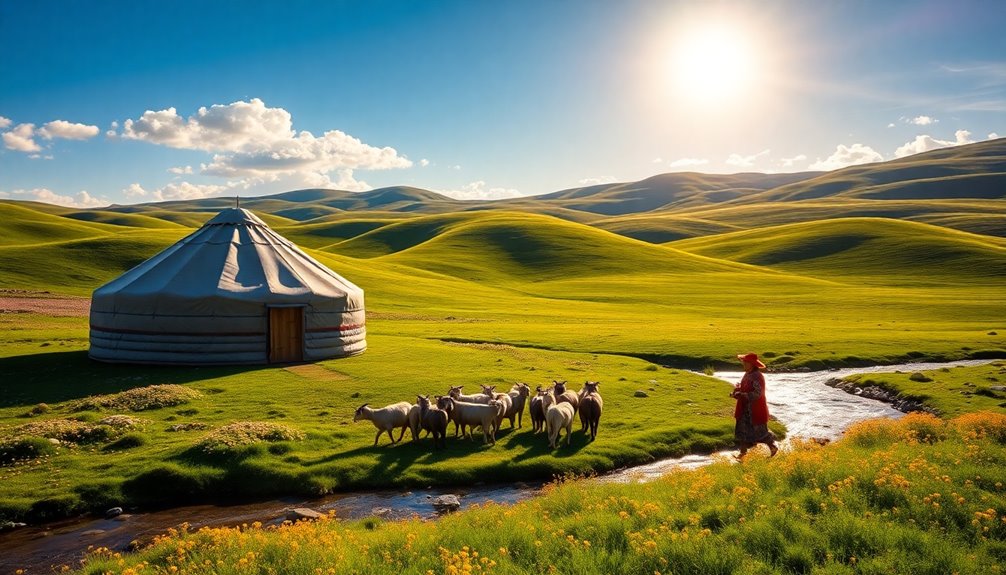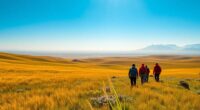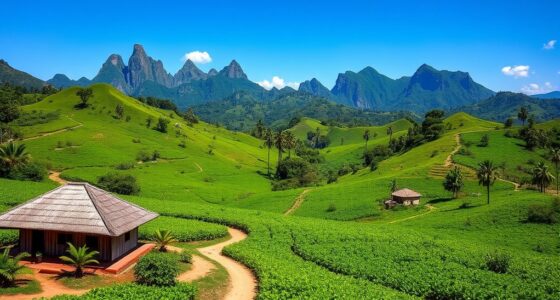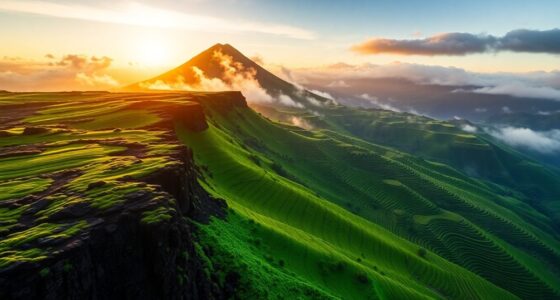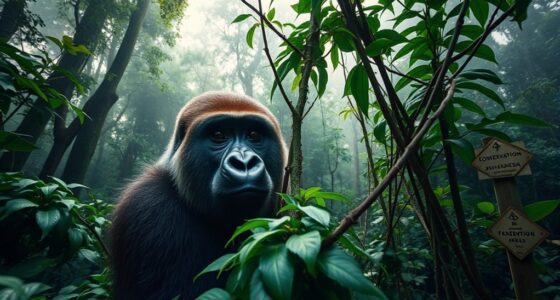Mongolia's Green Nomad Adventures merge sustainability with rich traditions. You'll find nomadic families practicing eco-friendly lifestyles, migrating seasonally to maintain balance within their unique ecosystems. Staying in traditional gers, you'll engage in daily activities like horse riding and cooking while supporting local cultures. The country's emphasis on using renewable resources, like animal dung for fuel, showcases their commitment to environmental stewardship. You'll also have opportunities to participate in community-led recycling initiatives and support local artisans. Each experience deepens your connection to the land and its people, guiding you toward a more enriching adventure in this stunning country. There's much more to explore!
Key Takeaways
- Engage with nomadic families through traditional stays in gers, experiencing their sustainable lifestyle and ecological practices firsthand.
- Participate in seasonal migrations to understand the harmony between nomadism and environmental conservation in Mongolia's vast landscapes.
- Explore local artisan workshops, such as felt-making and wood carving, to support cultural preservation and economic sustainability.
- Enjoy eco-friendly tours that prioritize wildlife conservation, minimizing environmental impact while appreciating Mongolia's rich biodiversity.
- Support local food initiatives, focusing on high-quality, sustainable ingredients that honor Mongolia's culinary traditions and promote local economies.
Introduction
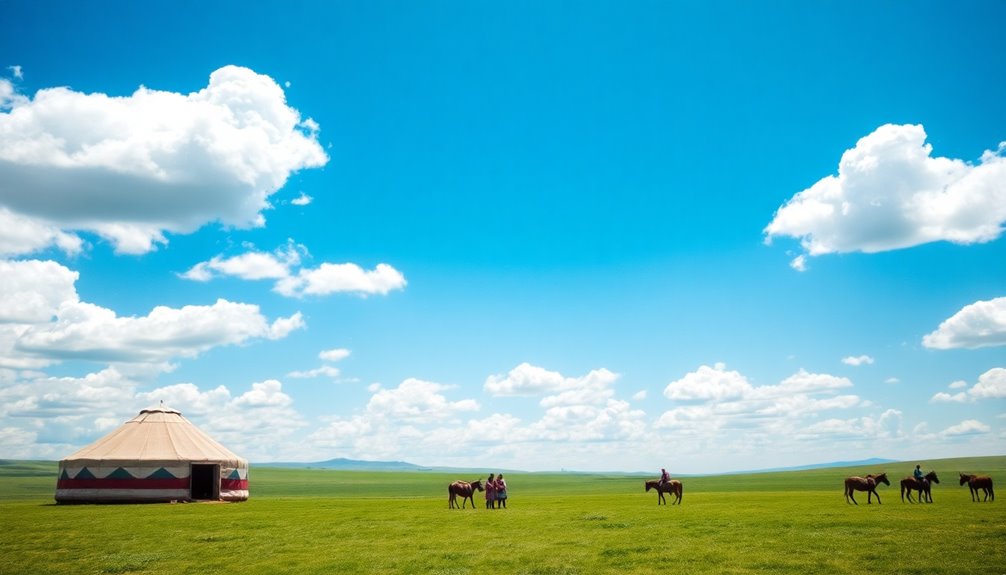
When you step into Mongolia, you're greeted by vast steppes and a rich tapestry of culture that thrives in harmony with nature.
The nomadic lifestyle not only preserves this unique heritage but also highlights the importance of eco-tourism in maintaining cultural traditions.
Vast Steppes and Rich Culture
As you step into Mongolia, the vast steppes unfold before you, revealing over 1.5 million square kilometers of breathtaking grassland that nurtures a unique ecosystem and vibrant nomadic culture.
Here, nomadic families thrive, migrating seasonally to preserve grazing lands and maintain ecological balance. They rely on "the five jewels"—camels, horses, cows, sheep, and goats—ensuring self-sufficiency through the diverse animal products they create for food, clothing, and shelter.
The construction of gers (yurts) showcases their adaptability, as these portable homes can be set up or taken down in under half a day.
With over 800 dairy products and clever use of resources, Mongolian nomads exemplify a sustainable lifestyle deeply rooted in tradition and environmental stewardship.
Cultural Preservation Through Eco-Tourism
Through eco-tourism, you can immerse yourself in Mongolia's rich nomadic culture while contributing to its preservation. Engaging with a nomadic family allows you to appreciate their traditional lifestyle and the wisdom passed down through generations.
By participating in eco-friendly practices, you're not only enjoying unique cultural experiences but also helping to maintain the delicate balance of Mongolia's ecosystems. UNESCO's recognition of nomadic culture highlights its significance, encouraging responsible tourism that benefits local economies.
When you learn traditional skills or join in seasonal migrations, you foster a deeper connection with the land and its people. Your involvement supports these communities, ensuring their cultural identity thrives while promoting sustainable living, making a lasting impact on both the environment and their heritage.
Travel From Ulaanbaatar to Ger
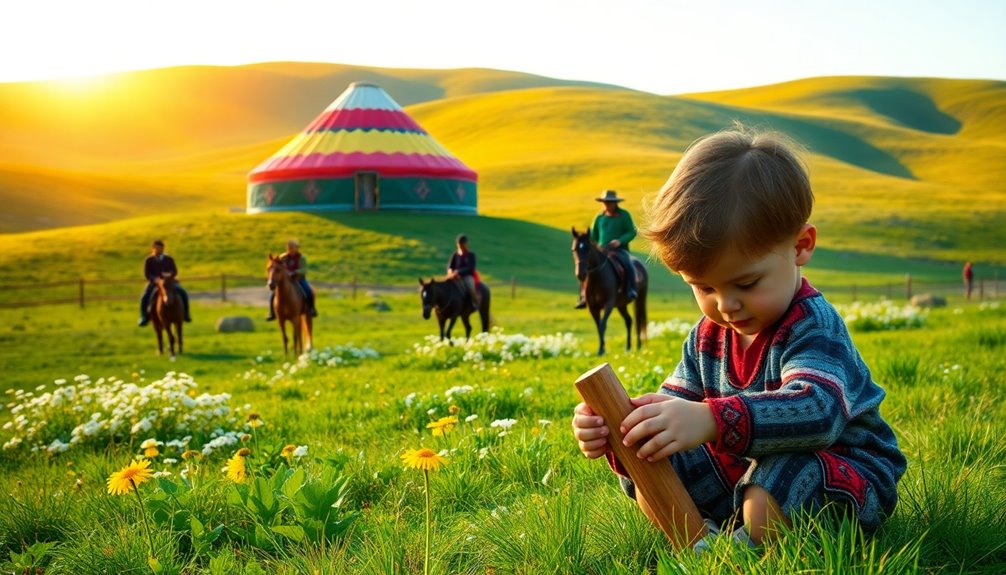
You can easily reach Ulaanbaatar with direct flights from Europe or even from Sydney.
Once you arrive, the adventure continues as you travel about 62 miles to a traditional ger, often on horseback or in an off-road vehicle.
This journey not only showcases Mongolia's stunning landscapes but also connects you with the nomadic lifestyle.
Fly Direct to Ulaanbaatar
Wondering how to escape the hustle and bustle of Ulaanbaatar and immerse yourself in Mongolia's nomadic lifestyle? You'll find that Ulaanbaatar is the perfect gateway, with direct flights connecting you to international destinations. Once you land, the journey to a ger is just 1-2 hours by car or minibus, allowing you to savor the stunning landscapes along the way.
| Landscape Type | Description |
|---|---|
| Vast Steppes | Expansive grasslands under a wide sky |
| Picturesque Mountains | Majestic peaks framing your route |
| Nomadic Families | Traditional gers dotting the horizon |
Traveling from Ulaanbaatar to a ger brings you face-to-face with Mongolia's rich culture and the beautiful contrast between urban life and serene nature.
Direct Flights From Europe
With direct flights from major European cities to Ulaanbaatar, reaching Mongolia's nomadic heart has never been easier. Major airlines operate regular routes to Chinggis Khaan International Airport, putting you just a step away from experiencing the vibrant culture of the nomadic people.
Ulaanbaatar serves as your gateway to vast landscapes where nomadic families live in traditional gers, offering unique cultural immersion opportunities. Once you arrive, you can easily arrange tours or experiences that take you directly into the nomadic lifestyle, including overnight stays with local families.
The convenience of these direct flights allows for flexible travel itineraries, letting you explore Mongolia's stunning natural beauty and rich cultural heritage without hassle. Your adventure awaits!
Flights From Sydney to Ulaanbaatar
Traveling from Sydney to Ulaanbaatar typically involves connecting flights, as direct routes aren't available. Major airlines like Air China and Mongolian Airlines offer options that take about 19 to 25 hours, including stopovers. Once you arrive in Ulaanbaatar, you're just 62 miles from the nomadic families living in traditional gers.
| Flight Duration | Airlines |
|---|---|
| 19 – 25 hours | Air China, Mongolian Airlines |
| Arrival in Ulaanbaatar | 62 miles from nomadic gers |
| Visa Requirement | Tourist visa needed |
Transportation to the ger can be arranged locally, taking around 1.5 to 2 hours. Remember, connectivity at nomadic placements is limited, so plan accordingly to stay in touch!
Horseback Riding Across the Steppe
After arriving in Ulaanbaatar, the adventure truly begins with a horseback riding journey across the steppe.
As you ride, you'll experience Mongolia's vast landscapes and the traditional nomadic life firsthand. Covering distances that nomads move during migration, this multi-day trek takes you to remote families living in their gers.
You'll engage in daily activities like herding livestock and milking animals, deepening your understanding of sustainable practices. The unique flora and fauna you encounter highlight the close relationship between nomads and their environment.
Guided tours offer insights into the cultural significance of the steppe, revealing historical routes used by nomadic tribes for centuries.
This immersive experience will leave you with unforgettable memories of Mongolia's rich traditions and natural beauty.
Mongolian Steppe Wildlife Tours
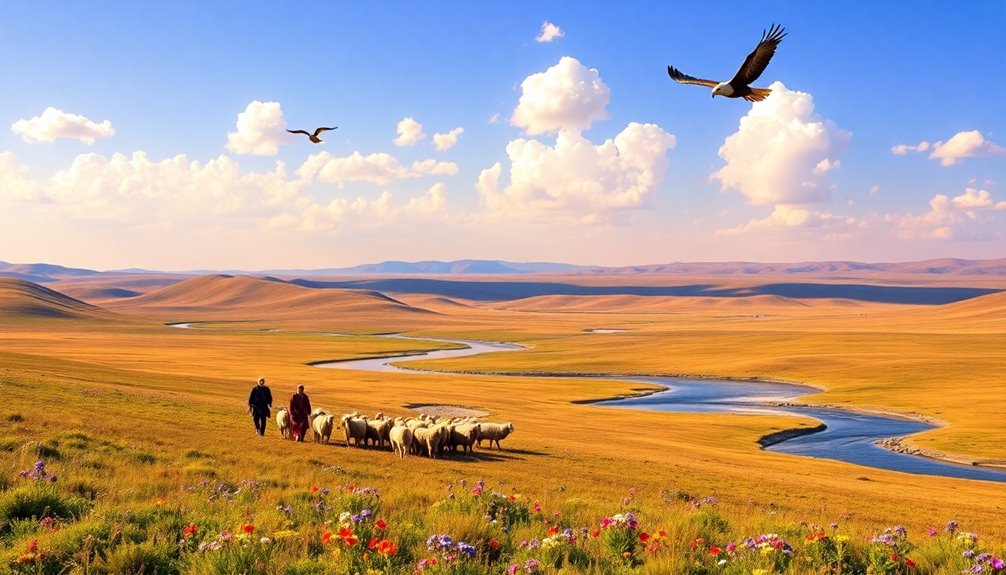
When you join a wildlife conservation volunteer opportunity in Mongolia, you'll help protect the unique species that call the steppe home.
Sustainable horseback riding tours let you experience the vast landscapes while minimizing your impact on the environment.
Plus, staying in a traditional ger connects you with local culture and enhances your adventure in this stunning wilderness.
Wildlife Conservation Volunteer Opportunities
With a deep commitment to protecting Mongolia's unique wildlife, wildlife conservation volunteer opportunities in the steppe offer you a chance to make a meaningful impact. Engage in field research, habitat restoration, and awareness campaigns, all while experiencing sustainable living alongside local nomadic communities. You'll work with experienced conservationists, gaining hands-on experience in wildlife monitoring and data collection.
| Activity | Focus Area | Duration |
|---|---|---|
| Field Research | Endangered Species | 1-2 weeks |
| Habitat Restoration | Ecosystem Health | 1 week |
| Awareness Campaigns | Community Engagement | Ongoing |
| Wildlife Monitoring | Data Collection | Year-round |
These wildlife conservation volunteer opportunities are available year-round, with peak activity in spring and summer, providing rich learning experiences.
Sustainable Horseback Riding Tours
Exploring Mongolia's vast steppe on horseback not only immerses you in breathtaking landscapes but also supports eco-friendly practices that honor the nomadic way of life.
These sustainable horseback riding tours allow you to traverse the region while minimizing your environmental impact. As you ride through this stunning terrain, you'll encounter Mongolia's diverse wildlife, including the endangered Przewalski's horse and a variety of bird species, all while learning about the delicate ecological balance of the area.
Traveling in small groups ensures minimal disruption to the environment, and you'll have the chance to engage with local nomadic families, discovering their traditional practices and commitment to sustainable living.
Your adventure contributes to the local economy, promoting conservation and preserving Mongolia's rich cultural heritage.
Traditional Ger Stays
Staying in a traditional ger immerses you in the heart of Mongolia's nomadic culture, where you'll experience daily life alongside local families.
These traditional ger stays allow you to connect directly with the rhythm of the steppe, engaging in activities like horse riding, herding, and traditional cooking. You'll gain a hands-on understanding of sustainable practices that define Mongolian nomadism while exploring breathtaking landscapes.
Wildlife tours often lead you to significant natural sites, highlighting Mongolia's rich biodiversity and the vital role of environmental stewardship.
By choosing traditional ger stays, you support the preservation of nomadic culture and sustainable tourism, ensuring local communities benefit economically while maintaining their heritage.
Dive into this unique experience and create unforgettable memories.
Eco-friendly Transportation Options
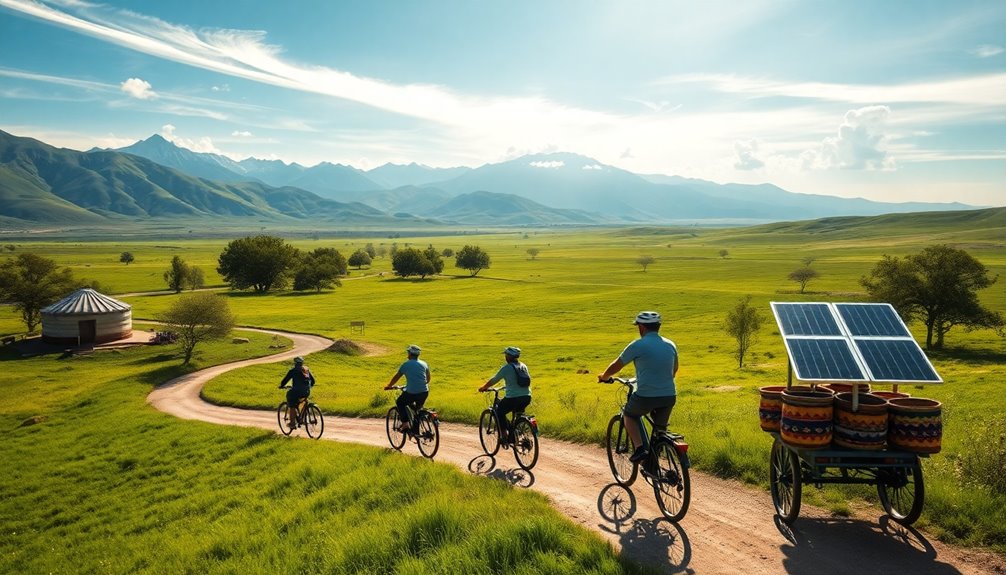
While traversing the vast landscapes of Mongolia, you'll find that nomadic communities rely on eco-friendly transportation options that harmonize with their environment.
Horses, camels, and oxen serve as the backbone of Mongolia's nomadic lifestyle, offering sustainable alternatives to motorized vehicles. These animals are well-suited for the terrain, facilitating the movement of traditional gers during seasonal migrations while minimizing environmental impact.
Nomadic families travel light, using pack animals to carry only essential belongings, which helps conserve resources and reduces waste. Additionally, they utilize animal dung as a fuel source, further decreasing reliance on non-renewable energy.
Community-Led Recycling Programs
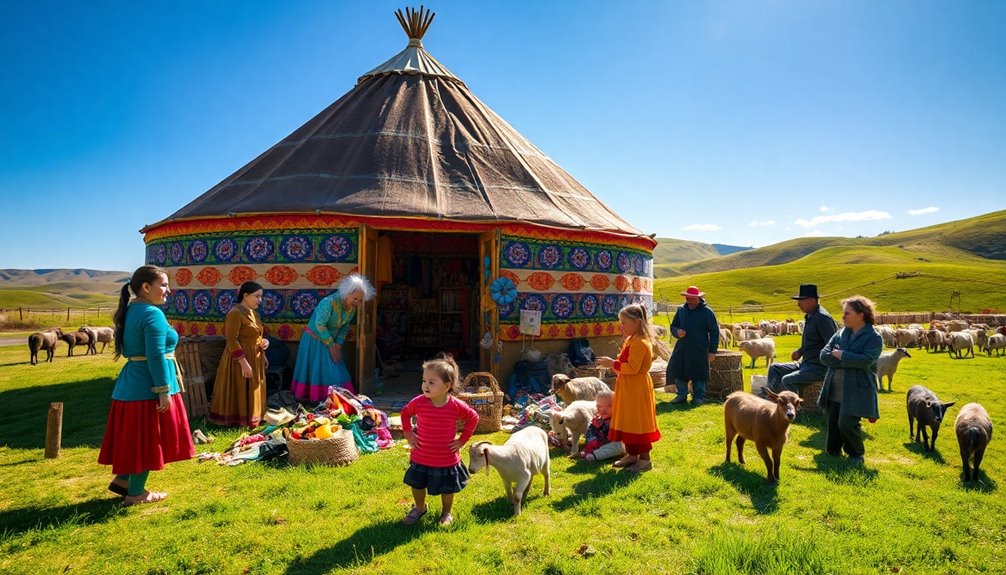
In Mongolia, community-led recycling programs are transforming how nomadic families approach waste management.
You'll see local NGOs and the government working together to create sustainable practices that not only help the environment but also strengthen community ties.
Government and NGO Efforts
Mongolia is taking significant strides in addressing its waste management crisis through community-led recycling programs, driven by collaborations between the government and NGOs.
These initiatives not only raise awareness but also empower communities to make a difference.
You can observe the impact in three key areas:
- Education: Workshops teach households and schools about recycling and upcycling.
- Job Creation: Local residents gain employment in waste collection and processing.
- Accessibility: Recycling depots established across Ulaanbaatar provide easy access to recycling facilities.
Through these government and NGO efforts, Mongolia is fostering a culture of environmental stewardship while significantly reducing landfill waste.
You'll see how these programs are shaping a greener future for the nation.
Community and Cultural Sustainability
As communities embrace sustainable practices, Mongolia's nomadic families are leading the charge in innovative recycling programs that reflect their deep-rooted respect for nature.
These community-led initiatives focus on reducing waste and promoting eco-friendly habits, seamlessly blending tradition with modern needs. You'll see local herder communities converting livestock waste into fuel and fertilizer, minimizing waste while maximizing resources.
Through collaboration with NGOs, nomads gain essential skills in effective waste management, ensuring they adapt without losing their cultural essence.
Educational workshops pave the way for understanding the importance of recycling, fostering not just environmental stewardship but also community resilience.
This commitment to sustainability helps preserve Mongolia's unique nomadic way of life amidst the challenges of urbanization and environmental degradation.
Spring Wildflower Bloom Season
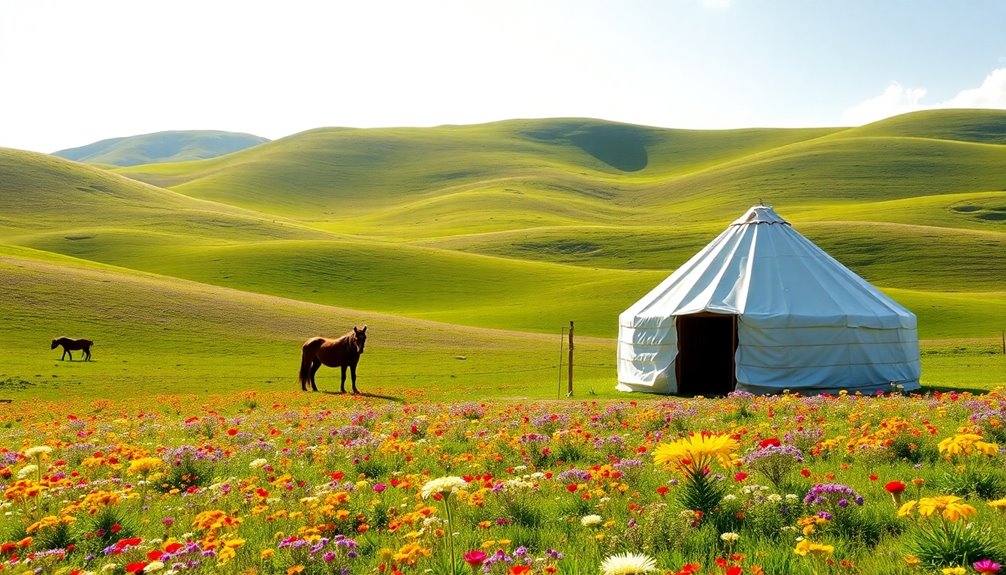
As spring arrives in Mongolia, vibrant wildflowers begin to blanket the landscape, creating a stunning backdrop for your adventures.
You'll notice the seasonal temperature fluctuations, bringing both warmth and brisk breezes that can impact your travel plans.
Embrace this breathtaking bloom season, where nature's beauty and the rhythm of nomadic life come together.
Spring Wildflower Bloom
There's nothing quite like witnessing the breathtaking spring wildflower bloom in Mongolia, which typically unfolds between late April and early June.
As you explore the steppes, you'll see vibrant carpets of color that transform the landscape. Picture yourself surrounded by:
- Delicate tulips swaying in the gentle breeze.
- Vivid anemones dotting the green fields like nature's confetti.
- Nutrient-rich grasses flourishing alongside, inviting herders and their livestock.
This bloom not only supports pollinators but also enriches Mongolia's unique ecosystems, maintaining environmental balance.
The herders, deeply connected to their land, use these wildflowers for traditional herbal remedies and teas.
Embrace the beauty of the spring wildflower bloom and witness how Mongolia's culture intertwines with its breathtaking nature.
Seasonal Temperature Fluctuations Impact Travel
While spring brings stunning wildflower blooms to Mongolia, it also introduces unpredictable temperature fluctuations that can impact your travel experience. With average temperatures ranging from 0°C to 15°C, you'll encounter warm days and chilly nights. These rapid changes can disrupt your plans, especially if you're eager to explore the nomadic lifestyle coinciding with seasonal migration patterns.
| Daytime Temperature | Nighttime Temperature |
|---|---|
| 15°C | 0°C |
| 10°C | -5°C |
| 12°C | -2°C |
Be prepared for sudden weather shifts, like unexpected snow or rain, which could affect your access to remote areas. Embrace the beauty of the wildflowers while staying adaptable; it's all part of the adventure!
How to Make Your Trip More Sustainable
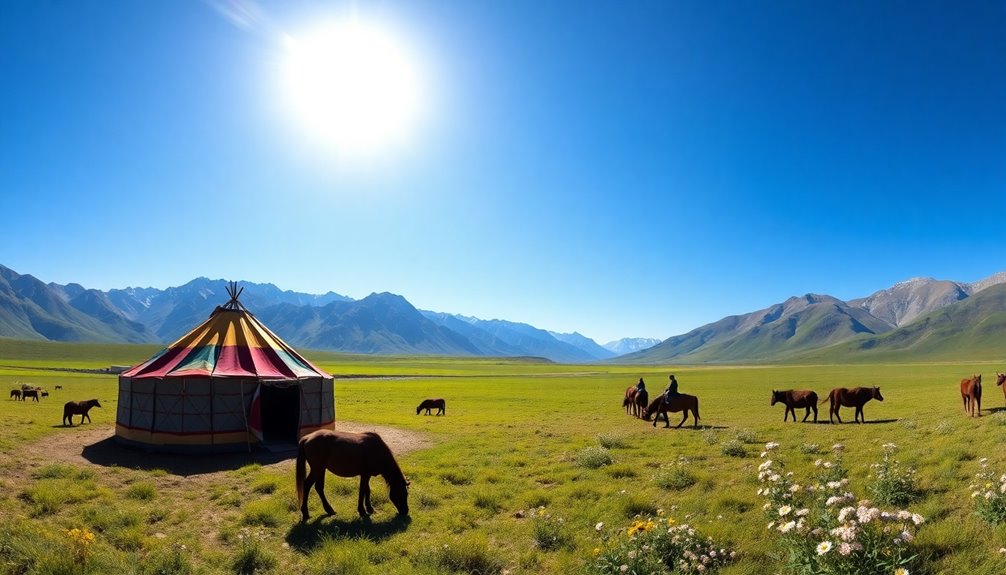
To make your trip more sustainable, consider using biodegradable toiletries and containers to reduce waste in Mongolia's pristine landscapes.
Supporting local artisans not only helps preserve traditional crafts but also boosts the local economy.
Biodegradable Toiletries and Containers
When planning your adventure in Mongolia's breathtaking landscapes, incorporating biodegradable toiletries and compostable containers can significantly reduce your environmental impact.
Here are some essential items to consider:
- Soap and shampoo bars: These biodegradable toiletries minimize plastic waste and are gentle on local ecosystems.
- Compostable food containers: They naturally decompose, preventing pollution in Mongolia's pristine environments.
- Reusable utensils: Opt for stainless steel or bamboo options to eliminate single-use plastics, embodying sustainable nomadic values. Additionally, consider using sustainable materials which can also enhance your overall eco-friendly approach.
Support Local Artisans
Supporting local artisans not only enriches your travel experience but also contributes to sustainable practices in Mongolia. When you purchase handmade products like traditional clothing and crafts, you support local livelihoods and help preserve cultural heritage.
Engage in workshops to learn skills such as felt-making and wood carving; this deepens your connection to the culture while boosting economic sustainability. Opt for eco-friendly, locally-sourced products to minimize your environmental footprint, aligning with Mongolia's commitment to combat climate change.
Choose businesses that prioritize ethical production and fair trade, ensuring artisans receive fair compensation. You can also donate to or volunteer with organizations empowering artisans through training, sustaining traditional crafts and enhancing community development. Additionally, consider supporting local food initiatives that promote high-quality ingredients and celebrate Mongolia's rich culinary traditions.
Your choices make a significant impact!
Frequently Asked Questions
What Are the Nomadic Traditions in Mongolia?
In Mongolia, nomadic traditions revolve around a sustainable lifestyle that relies on the "Five Jewels": camels, horses, cows, sheep, and goats.
You'll find that families move every few months, setting up and dismantling their gers quickly to adapt to seasonal changes. They practice careful grazing management, ensuring the land remains healthy.
Skills and knowledge are passed down through generations, creating a strong cultural identity and showcasing their resourcefulness through over 800 dairy products.
Do Nomads Still Exist in Mongolia?
Yes, nomads still exist in Mongolia, and you'll find about 30% of the population living a traditional nomadic lifestyle.
They rely on livestock for their survival, owning up to 500 animals like camels, horses, and sheep.
These families migrate seasonally to preserve grazing lands, showcasing their connection to nature.
Despite facing challenges from climate change, many continue practicing sustainable methods, ensuring their way of life adapts to modern pressures while honoring their traditions.
How Do Mongolian Nomads Get Water?
Mongolian nomads get water by strategically locating seasonal rivers, lakes, and natural springs, often based on their historical knowledge.
During migrations, you'll see them carrying water in large containers to sustain themselves and their livestock.
In spring, they gather snowmelt, melting it for drinking and irrigation.
They carefully monitor their water usage, ensuring they leave no waste behind, which helps maintain ecological balance and supports future generations' needs.
How Do Mongolian Nomads Make Money?
Did you know that Mongolian nomads typically own up to 500 animals? They primarily make money through livestock production, selling milk, meat, and wool.
The cashmere industry also boosts their income, as Mongolia is one of the largest cashmere producers.
Seasonal tourism allows you to experience their culture firsthand, while selling over 800 dairy varieties, like aaruul and borts, helps diversify their revenue streams and adapt to climate challenges.
Conclusion
As you explore Mongolia's breathtaking landscapes and vibrant culture, you'll discover how tradition and sustainability can coexist beautifully. By choosing eco-friendly options and supporting local communities, you're not just a traveler; you're a steward of this incredible land. Isn't it rewarding to know that your adventures can help preserve such a unique environment for future generations? Embrace the spirit of the green nomad and make every journey count towards a more sustainable future.

